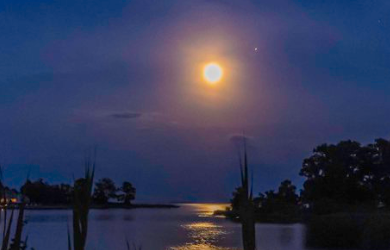Yeah, it’s still beautiful, but to call it a strawberry moon just doesn’t make sense. Tonight, though you can see it
Despite its name, June’s full moon will not resemble a strawberry. However, the bright orb is expected to captivate viewers Friday night with a larger and more colorful appearance than the average moon.
The full moon, reaching its peak fullness at 9:08 p.m. ET Friday, comes just one day after the summer solstice, when the sun is at its highest point in the sky for the Northern Hemisphere. Because a full moon is opposite the sun, this “strawberry moon” will shine lower in the sky than usual, according to NASA.
June full moon: What the solstice strawberry moon means for your zodiac https://t.co/0jXXIiQSDq pic.twitter.com/urQMftWEQC
— Eyewitness News (@ABC7NY) June 21, 2024
Due to this lower path across the sky, the full moon might exhibit an orange or amber hue, similar to the coloration of sunsets. This phenomenon occurs because the moon’s reflected light travels a longer distance through Earth’s atmosphere, scattering shorter blue wavelengths and leaving the longer red wavelengths more visible, explained Preston Dyches, a science communicator with NASA’s Jet Propulsion Laboratory.
The name “strawberry moon” was given by Native American tribes across North America to signify the ripeness of strawberries during this time, according to The Old Farmer’s Almanac.
The June full moon will occur tonight. It’s called the Strawberry Moon. More detailed weather data for your neighborhood at https://t.co/E6sxWE4Yaa #ecarwx #ncwx #weather #wctiwx pic.twitter.com/gYwpNPyQEW
— WCTI Weather Center (@StormTrack12) June 21, 2024
Additionally, the moon’s low placement could make it appear larger than usual, an effect known as the moon illusion. While the exact cause of this optical illusion remains unclear, it is thought to be a combination of how our brains process visual information and the moon’s size in comparison to nearby objects such as trees or buildings.
Dyches recommends viewing the moon as it rises or sets to best experience the moon illusion. No special equipment is needed to observe a full moon, but a telescope or binoculars can enhance the viewing experience, highlighting the moon’s features, as suggested by NASA’s Moon Viewing Guide.
“It’s worth a few minutes of your time whenever you can experience something beautiful about the environment right outside your door,” Dyches remarked. Marveling at the sight of another enormous globe is satisfying. I enjoy looking up and picturing it as a future home and workplace for people.
The strawberry moon will appear full for three days around its peak, making it visible to almost everyone worldwide. However, those in northern regions like Alaska or Denmark may find it more challenging to observe, as the low-traversing moon will only briefly rise above the horizon.
LOOK UP: June’s full moon will peak tonight at 8:08 PM CT! It is known as the strawberry moon because this is the time of year when strawberries are ripe and ready for harvest.#ARwx #LAwx #MSwx pic.twitter.com/PzYlHeYjdI
— DeVonte’ Dixon (@DDixonWx) June 21, 2024
In addition to the full moon, viewers in the Northern Hemisphere can also spot the “Summer Triangle,” a trio of bright stars symbolizing summertime. The brightest of these stars, Vega, will be visible in the eastern sky, with Altair to its lower right and Deneb to the lower left, forming the triangular pattern.
Away from city lights, observers can also see the center of the Milky Way as a hazy band of dim clouds arching across the sky. The constellation Scorpius will be visible, pointing the way to the galaxy’s core.
For the remainder of 2024, there are six more full moons to look forward to:
July 21: Buck moon
August 19: Sturgeon moon
September 17: Harvest moon
October 17: Hunter’s moon
November 15: Beaver moon
December 15: Cold moon
Each of these full moons offers a unique opportunity to marvel at the night sky and appreciate the natural beauty of our celestial neighbor.
Key Points:
i. June’s full moon, known as the strawberry moon, will appear larger and more colorful on Friday night, reaching peak fullness at 9:08 p.m. ET.
ii. The moon will shine lower in the sky, causing it to appear orange or amber due to the scattering of shorter blue wavelengths by Earth’s atmosphere.
iii. Named by Native American tribes to mark the ripeness of strawberries, the strawberry moon also exhibits the moon illusion, making it appear larger near the horizon.
iv. For optimal viewing, it’s recommended to watch the moon as it rises or sets, with a telescope or binoculars enhancing the experience.
v. Besides the full moon, the Northern Hemisphere can also see the Summer Triangle and the Milky Way’s center, with the remaining full moons of 2024 being the Buck moon, Sturgeon moon, Harvest moon, Hunter’s moon, Beaver moon, and Cold moon.
Beatrice Morano – Reprinted with permission of Whatfinger News



